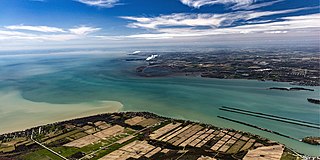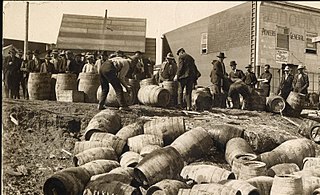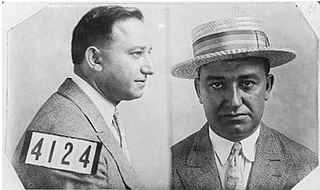Related Research Articles

Canadian whisky is a type of whisky produced in Canada. Most Canadian whiskies are blended multi-grain liquors containing a large percentage of corn spirits, and are typically lighter and smoother than other whisky styles. When Canadian distillers began adding small amounts of highly-flavourful rye grain to their mashes, people began demanding this new rye-flavoured whisky, referring to it simply as "rye". Today, as for the past two centuries, the terms "rye whisky" and "Canadian whisky" are used interchangeably in Canada and refer to exactly the same product, which generally is made with only a small amount of rye grain.

The Detroit River flows west and south for 24 nautical miles from Lake St. Clair to Lake Erie as a strait in the Great Lakes system. The river divides the metropolitan areas of Detroit, Michigan, and Windsor, Ontario—an area collectively referred to as Detroit–Windsor—and forms part of the border between Canada and the United States. The Ambassador Bridge, the Detroit–Windsor Tunnel, and the Michigan Central Railway Tunnel connect the cities.

The National Prohibition Act, known informally as the Volstead Act, was an act of the 66th United States Congress, designed to carry out the intent of the 18th Amendment, which established the prohibition of alcoholic drinks. The Anti-Saloon League's Wayne Wheeler conceived and drafted the bill, which was named after Andrew Volstead, chairman of the House Judiciary Committee, who managed the legislation.
Charles Henry "Marty" Gervais, born in 1946 in Windsor, Ontario, is a Canadian poet, photographer, professor, journalist, and publisher of Black Moss Press.

Lakeshore is a municipality on Lake St. Clair, in Essex County, Ontario, Canada. It was incorporated in 1999 by amalgamating the Town of Belle River with the townships of Maidstone, Rochester, Tilbury North, and Tilbury West. It is the largest and the most populous municipality within Essex County. However, it is part of the Windsor census metropolitan area.

William Frederick "Bill" McCoy, was an American sea captain and rum-runner during the Prohibition in the United States. In pursuing the trade of smuggling alcohol from the Bahamas to the Eastern Seaboard, Capt. McCoy, found a role model in John Hancock of pre-revolutionary Boston and considered himself an "honest lawbreaker." McCoy took pride in the fact that he never paid a cent to organized crime, politicians, or law enforcement for protection. Unlike many operations that illegally produced and smuggled alcohol for consumption during Prohibition, McCoy sold his merchandise unadulterated, uncut and clean.

Rum-running or bootlegging is the illegal business of smuggling alcoholic beverages where such transportation is forbidden by law. Smuggling usually takes place to circumvent taxation or prohibition laws within a particular jurisdiction. The term rum-running is more commonly applied to smuggling over water; bootlegging is applied to smuggling over land.

Canadian Club is a brand of Canadian whisky produced by Beam Suntory. Popularly known as CC, Canadian Club was created by Hiram Walker and Sons, an evolution of a brand around a product that took place over the second half of the nineteenth century. Hiram Walker merged with Gooderham & Worts, Ltd. in 1926, yielding Hiram Walker-Gooderham & Worts, Ltd.

A rum row was a Prohibition-era term (1920–1933) referring to a line of ships loaded with liquor anchored beyond the maritime limit of the United States. These ships taunted the Eighteenth Amendment’s prohibition on the sale and consumption of alcoholic beverages. Although rum prevailed along Caribbean shores, other beverages were popular elsewhere.

The Atlantic City Conference held between 13–16 May 1929 was a historic summit of leaders of organized crime in the United States. It is considered by most crime historians to be the earliest organized crime summit held in the US. The conference had a major impact on the future direction of the criminal underworld and it held more importance and significance than the Havana Conference of 1946 and the Apalachin meeting of 1957. It also represented the first concrete move toward a National Crime Syndicate.
Thomas "Yonnie" Licavoli was an American gangster and bootlegger during Prohibition. Born in St. Louis, Missouri, Licavoli, along with brother Peter Joseph Licavoli and cousin James Licavoli, worked with Jewish gangsters to take over illegal gambling in St. Louis. The Licavolis soon moved on to Detroit, Michigan and would control criminal operations in Detroit and Toledo, Ohio, throughout the Prohibition era.
Abe Bernstein was a Detroit-based Jewish-American organized crime figure and leader of the infamous Prohibition-era Purple Gang.

Rocco Perri was an Italian-born organized crime figure in Hamilton, Ontario, Canada. He was one of the most prominent Prohibition-era crime figures in Canada, and was sometimes referred to as "King of the Bootleggers" and "Canada's Al Capone."
Govenlock is an unincorporated community within Rural Municipality of Reno No. 51, Saskatchewan, Canada. It previously held the status of a village, with a peak population of 151 residents; its village status was dissolved on January 1, 1976. The former townsite of Govenlock is located on Highway 21 & Highway 13, also known as the historic Red Coat Trail, about 15 km east of the Alberta-Saskatchewan border. Although many cement foundations and wooden sidewalks can still be found scattered around the town site, the only building that still stands as of 2010 is the old community hall and a commemorative plaque in remembrance of Govenlock's rich history.
James Cooper was a Canadian bootlegger who gained prosperity through the prohibition era. Cooper became one of the wealthiest and most powerful bootleggers in Canada.

Charles Dean O'Banion was an American mobster who was the main rival of Johnny Torrio and Al Capone during the brutal Chicago bootlegging wars of the 1920s. The newspapers of his day made him better known as Dion O'Banion, although he never went by that first name. He led the North Side Gang until 1924, when he was shot and killed, reportedly by Frankie Yale, John Scalise and Albert Anselmi.

Rum-running in Windsor, Ontario, Canada, was a major activity in the early part of the 20th century. In 1916, the State of Michigan, in the United States, banned the sale of alcohol, three years before prohibition became the national law in 1919. From that point forward, the City of Windsor, Ontario was a major site for alcohol smuggling and gang activity.
John Oswald Leslie Spracklin a Methodist minister from Windsor, Ontario, Canada, noted for his involvement with Prohibition issues. Spracklin shot and killed a man who was engaged in the illicit liquor trade and was later acquitted of manslaughter, after which experience he decided to emigrate to the United States.

The Purple Gang, also known as the Sugar House Gang, was a criminal mob of bootleggers and hijackers comprised predominantly of Jewish gangsters. They operated in Detroit, Michigan, during the 1920s of the Prohibition era and came to be Detroit's dominant criminal gang. Excessive violence and infighting caused the gang to destroy itself in the 1930s.
The Triaca Company was a brewery and distributor located in Baltimore, Maryland.
References
- 1 2 3 "Blaise Diesbourg". Our Freeman Family. Retrieved March 26, 2014.
- ↑ Marty Gervais, The Rumrunners: A Prohibition Scrapbook (Canada: Library and Archives Canada Cataloguing in Publication, 1980, 2009), 51.
- ↑ Marty Gervais, "Rum Runners", Bilioasis, Emeryville, Canada, 2009, pg.38
- ↑ Davis, C. Mark (1985). "Atlantic Canada's Rum Running Tradition". Acadiensis . 14 (2): 149–50.
- ↑ Philip P. Mason, Rumrunning and The Roaring Twenties: Prohibition on the Michigan-Ontario Waterway(Detroit: Wayne State University Press, 1995), front flap.
- ↑ B.H.Spence, "Prohibitory Legislation in Canada," Annals of the American Academy of Political and Social Science 109 (1923): 239.
- ↑ Marty Gervais, The Rumrunners: A Prohibition Scrapbook (Canada: Library and Archives Canada Cataloguing in Publication, 1980, 2009), 53.
- ↑ Marty Gervais, The Rumrunners: A Prohibition Scrapbook (Canada: Library and Archives Canada Cataloguing in Publication, 1980, 2009), 56.
- 1 2 Marty Gervais, The Rumrunners: A Prohibition Scrapbook (Canada: Library and Archives Canada Cataloguing in Publication, 1980, 2009), 58.
- ↑ Gary Rennie, ";Grand Bend' Visions for Belle River; Councillor sees tourism possibilities," The Windsor Star, September 9, 2012, A5.